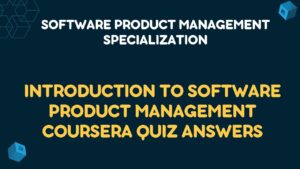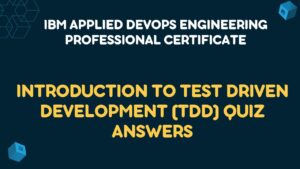All Week Fundamentals of Network Communication Coursera Quiz Answers
Table of Contents
Fundamentals of Network Communication Week 01 Quiz Answers
Practice Assessment – Communication Networks and Services
Q1. Which of the following networks use store-and-forward switching operation?
- Telephone networks
- Wireless Networks
- Computer networks
- Telegraph networks
Q2. There are similarities between message switching and packet switching. Which of following that applies to packet switching but not to message switching?
- Variable length of information block
- Supporting multiple applications
- Store-and-forward
- All of the above
Q3. Which of the following networks can be connection-oriented?
- Telegraph networks
- Computer networks
- Telephone networks
- All of the above
Q4. A protocol is a set of precise and unambiguous rules that governs
- How two or more communicating entities in a layer are to interact
- Messages that can be sent and received
- Actions that are to be taken when a certain event occurs
- All of the above
Q5. DNS is a domain-name-service that responds to queries of domain name to IP address or IP address to domain name. DNS uses services provided by
- TCP
- UDP
- HTTP
- None of the above
Q6. A network used to join the individual networks at different sites into one extended network is called
- PAN
- LAN
- SAN
- VPN
Q7. Upon receipt of a bad segment, UDP?
- Retransmission
- It does flow control
- It does not do flow and error control
- It does error control
Graded Assessment – Communication Networks and Services
Q1. Which of following protocol is HTTP built upon?
- UDP
- SMTP
- TCP
- IP
Q2. Which of following requirements are necessary for packet networks to support multiple and diverse applications?
- Transfer arbitrary message size
- Low delay for interactive applications
- Packets have maximum length
- All of the above
Q3. What was the concern of the telephone system that motivated the ARPANET design?
- Scalability
- Vulnerability
- Efficiency
- None of the above
Q4. Which of the following is an application layer protocol?
- HTTP
- UDP
- DNS
- TCP
Q5. Which of the following are features of ARPANET design?
- Connectionless packet transmission
- Routing tables at the packet switches
- Destinations identified by unique addresses
- All of the above
Q6. Bluetooth is an example of
- Local Area Network
- Metropolitan Area Network
- Personal Area Network
- Wide Area Network
Q7. In the layer hierarchy as the data packet moves from the upper to the lower layers, headers are
- Removed
- Modified
- Added
- Rearranged
Q8. The ________ is the physical path over which a message travels
- Path
- Protocol
- Medium
- Route
Q9. Three or more devices share a link in ________ connection
- Unipoint
- Multipoint
- Point to Point
- None of the above
Q10. Which of the following is true for Transport Control Protocol
- Connection oriented
- Process to Process
- Transport layer protocol
- Connectionless
Fundamentals of Network Communication Week 02 Quiz Answers
Practice Assessment – Layered Architecture
Q1. Which OSI layer is responsible for providing end-to-end communication with reliable service?
- Transport layer
- Data link layer
- Network layer
- Session layer
Q2. Which OSI layer is responsible for dividing the transmitted bit stream into frames?
- Application layer
- Network layer
- Transport layer
- Data link layer
Q3. Which OSI layer is responsible for determining which route through the network to use?
- Network layer
- Data link layer
- Transport layer
- None of the above
Q4. Which feature does the data link layer and transport layer have in common?
- Congestion control
- All of the above
- Flow control
- Medium access control
Q5. Which protocol glues the network of networks together as the Internet?
- TCP
- UDP
- IP
- None of the above
Graded Assessment – Layered Architecture
Q1. In a LAN, which address is used to transfer frames to appropriate destination?
- IP address
- Physical address
- Domain name
- None of the above
Q2. Suppose an application layer entity wants to send an L-byte message to its peer process, using an existing TCP connection. The TCP segment consists of the message plus 20 bytes of header. The segment is encapsulated into an IP packet that has an additional 20 bytes of header. The IP packet in turn goes inside an Ethernet frame that has 18 bytes of header and trailer. What is the bandwidth utilization in terms of the percentage of the transmitted bits in the physical layer corresponds to message information if L = 500 bytes?
- 100%
- 80%
- 90%
- 70%
Q3. Of the following services, which service(s) does the IP layer provides?
- Error control
- Flow control
- Connection-based data transfer
- None of the above
Q4. Which of the following is true about the ways in which the OSI reference model and TCP/IP reference model differ.
- TCP/IP model does not have session layer, but OSI model has
- All of the above
- They differ in the number of layers
- TCP/IP model does not have presentation layer, but OSI model has
Q5. Which of following statements is true about how the data link layer and transport layer differ?
- Data link layer is concerned with framing and the transport layer is not
- Data link layer is concerned with flow control and the transport layer is not
- Data link layer is concerned with multiplexing and the transport layer is not
- All of the above
Q6. This layer is an addition to OSI model
- Application layer
- Presentation layer
- Session layer
- Presentation layer and Session layer
Q7. The functionalities of presentation layer includes
- Data compression
- Data encryption
- Data decryption
- All of the above
Fundamentals of Network Communication Week 03 Quiz Answers
Practice Assessment – Socket API & Digital Transmissions
Q1. Which of the following applications would you select TCP protocol for?
- None of the above
- Web browsing
- File transfer
- Domain name service
Q2. In BSD socket API, which type of socket is used to create a TCP socket?
- SOCK_STREAM
- SOCK_RAW
- SOCK_DGRAM
- None of the above
Q3. In BSD socket API, which type of socket is used to create a UDP socket?
- SOCK_STREAM
- SOCK_DGRAM
- SOCK_RAW
- None of the above
Q4. In BSD socket API, which system call is used to assign a network address to the socket?
- None of the above
- listen()
- connect()
- bind()
Q5. In BSD socket API, if a client knows the server name but not server’s network address, what system call should the client use to get server’s network address?
- None of the above
- Connect()
- gettimeofday()
- gethostbyname()
Q6. In a transmission system, which of the following statement is true for a receiver
- Receives energy from medium
- Converts information into signal suitable for transmission
- Converts received signal into a form suitable for delivery to user
- All of the above
Q7. In digital transmission, long distance digital communications require the use of a generator to recover original data sequence and re-transmits on next segment
- True
- False
Q8. In twisted pair, a category 5 UTP cable can support a data rate of up to 16MHz
- True
- False
Q9. Which of the following statement is true for optical fiber
- Plentiful bandwidth for new services
- Dominates long distance transmission
- Distance less of a cost factor in communications
- All of the above
Q10. Which of the following are advantages of optical fiber
- Extremely low bandwidth
- Noise immunity
- No corrosion
- Wavelength dependency
Graded Assessment – Socket API & Digital Transmissions
Q1. In BSD socket API, which call is usually used for transmitting data in the connectionless mode?
- accept()
- connect()
- sendto()
- None of the above
Q2. Which of following statement about TCP/UDP sockets is wrong?
- TCP socket is stream oriented
- UDP socket is block oriented
- TCP is faster than UDP
- All of the above
Q3. Which of following are commonly used as digital communication medium?
- Optical fiber
- Twisted pair
- Coaxial cable
- All of the above
Q4. Consider a network link that has distance of 100 meters, and signal traverses at the speed of light in cable 2.5 x 10^8 meters per second. The link has transmission bandwidth of 100 megabits/second (100 x 10^6 bits per second). The packet size is 400 bits. What is the signal propagation delay?
- 4 x 10^-7 seconds
- None of the above
- 4 x 10^-6 seconds
- 4 x 10^-9 seconds
Q5. Consider a network link that has distance of 100 meters, and signal traverses at the speed of light in cable 2.5 x 10^8 meters per second. The link has transmission bandwidth of 100 megabits/second (100 x 10^6 bits per second). The packet size is 400 bits. What is the packet transmission delay?
- 4 x 10^-9 seconds
- None of the above
- 4 x 10^-6 seconds
- 4 x 10^-7 seconds
Q6. An API allows application programs to access certain resources through a predefined interface?
- True
- False
Q7. In transport protocol, which of the following statements is true for User Datagram Protocol
- It enables best-effort connectionless transfer of individual block of information
- It enables connection-oriented reliable transfer of individual block of information
- It enables best-effort connectionless reliable transfer of a stream of bytes
- None of the above
Q8. Which of the following sentences are true for connectionless stream mode of service
- Multiple write/read between peer processes
- Destination address with each block
- Send/receive to/from multiple peer processes
- No setup overhead and delay
Q9. In transmission delay, in order to reduce the number of bits in a message we use data compression
- True
- False
Q10. Which of the following is true of data compression algorithms
- Recover information approximately
- Modify data headers
- Represent the information using fewer bits
- Recover original information exactly
Fundamentals of Network Communication Week 04 Quiz Answers
Practice Assessment – Error Control
Q1. Given a 7-bit information frame (0, 1, 0, 1, 1, 0, 1), what is the even parity bit?
- 1
- 0
- None of the above
Q2. Which of following statements are true for single-bit parity error detection?
- It can detect all single bit errors in an information frame
- It can detect all double bit errors in an information frame
- It can detect all tripe bit errors in an information frame
- None of the above
Q3. Which of following statements are true for two-dimensional parity error detection?
- It can detect all single bit errors in an information frame
- It can correct all single bit errors in an information frame
- It can detect all double bit errors in an information frame
- All of the above
Q4. Assume bit errors occur at random. If each bit has 50% probability to be in error by transmission. What is the probability of a four-bit frame to be in error by transmission?
- 1/4
- 1/8
- 1/16
- None of the above
Q5. What is the binary sequence that corresponds to polynomial code X^3 + x^2 + 1?
- 1101
- 0111
- 1110
- 111
Q6. Block codes are generated using _____.
- Generator matrix
- Generator polynomial
- Both of the mentioned
- None of the mentioned
Q7. Which of the following is true for two-dimensional parity check
- Arrange information in columns
- Add multiple parity bits to each column
- More parity bit to improve coverage
- Arrange information in rows
Q8. Polynomial codes are implemented using shift register circuits
- True
- False
Q9. What is the binary equivalent of the following polynomial arithmetic
x7 + x6 + x5 + x2 + 1
- 11100101
- 11101101
- 11011101
- 11100111
Q10. Using Euclidean Division, what will be the remainder of 70 by 999 where 70 is the divisor and 999 is the dividend
- 19
- 14
- 17
- 21
Graded Assessment – Error Control
Q1. Given an information polynomial code I(x) = X^7 + x^6 + x^1 + 1, which is its corresponding per-bit information frame?
- 10100010
- None of the above
- 11000011
- 01100011
Q2. What is the remainder obtained by dividing x^7 + x^5 + 1 by the generator polynomial x^3 + 1?
- x^2 + x
- x^2 + x + 1
- None of the above
- x^2 + 1
Q3. Given a generator polynomial g(x) = x^3 + x + 1. Consider the information sequence 1001. By CRC method, what is the resulted codeword for transmission?
- 1001111
- 1001000
- 1001110
- 1010110
Q4. Which of following generator polynomial can detect all single bit errors in an information frame?
- g(x) = x
- g(x) = x^2
- g(x) = x + 1
- All of the above
Q5. Internet protocols use check bits to detect errors, instead of using CRC polynomial. The primary rationale is
- Strength of error detection capability
- Simplicity of implementation
- CRC polynomial cannot work for Internet protocols
- None of the above
Q6. The two basic approaches in error control are error prevention and detection, and error correction and re-transmission
- True
- False
Q7. Find parity bit for 1001011
- 0
- 1
- 2
- None of the above
Q8. The divisor in a cyclic code is normally called the _________.
- Degree
- Redundancy
- Generator
- None of the above
Q9. The checksum of 0000 and 0000 is
- 0101
- 1010
- 1111
- 0000
Q10. In ASCII, a single parity bit code can detect ________ errors.
- An even number of
- No errors
- An odd number of
- Two
Get All Course Quiz Answers of Computer Communications Specialization
Fundamentals of Network Communication Coursera Quiz Answers
Peer-to-Peer Protocols and Local Area Networks Coursera Quiz Answers
Packet Switching Networks and Algorithms Coursera Quiz Answers
TCP/IP and Advanced Topics Coursera Quiz Answers




